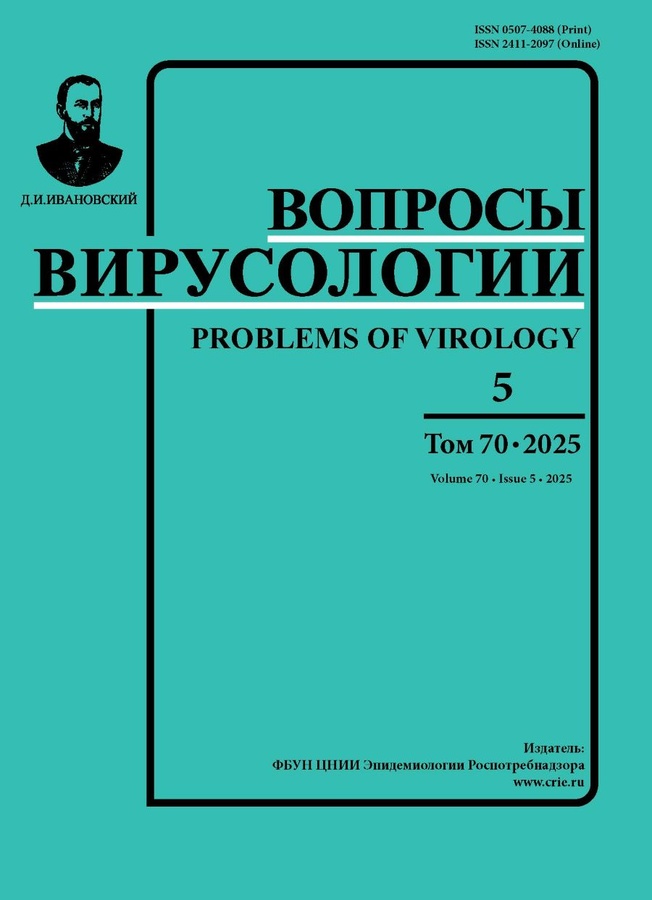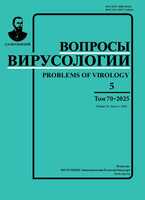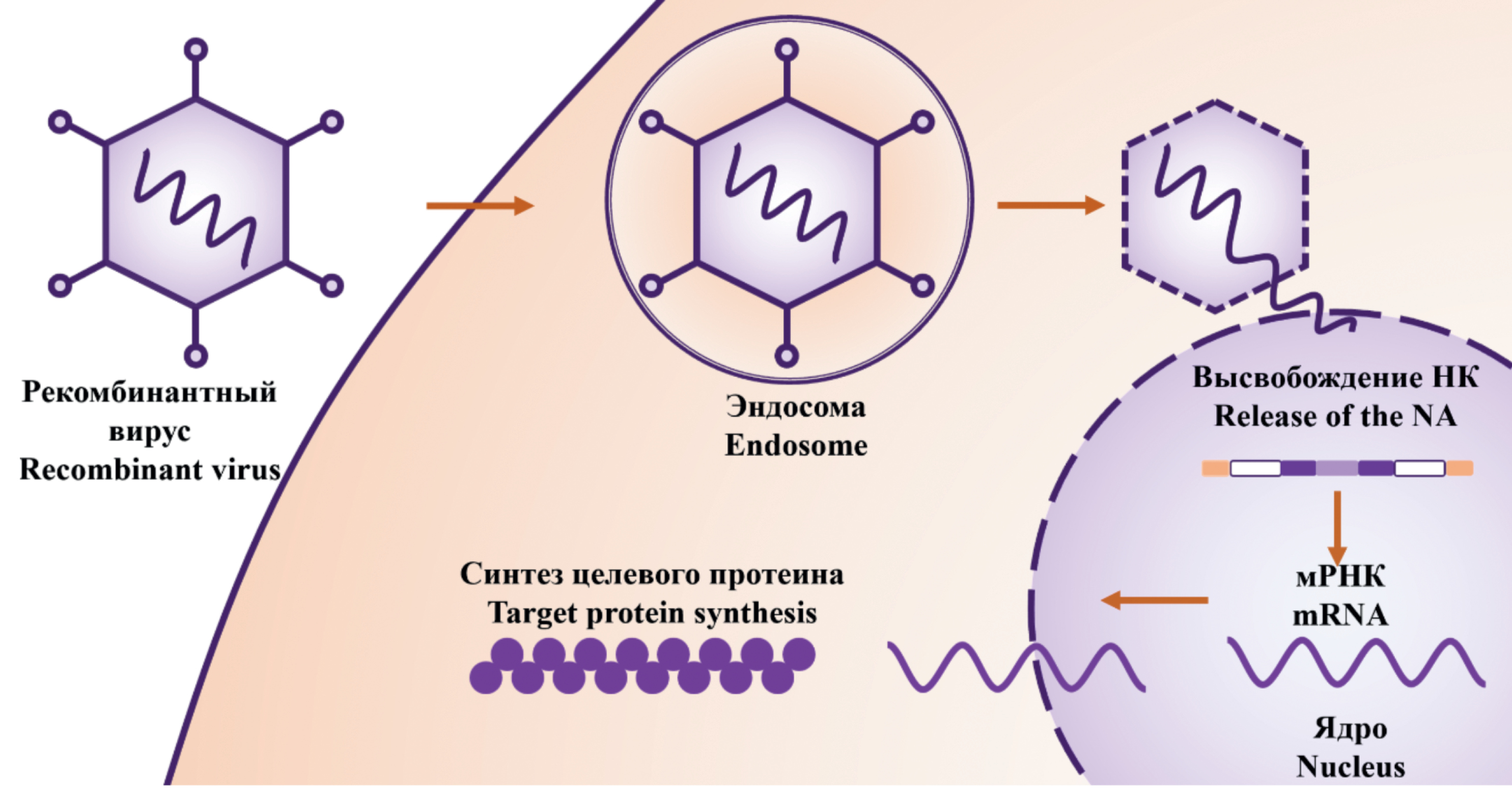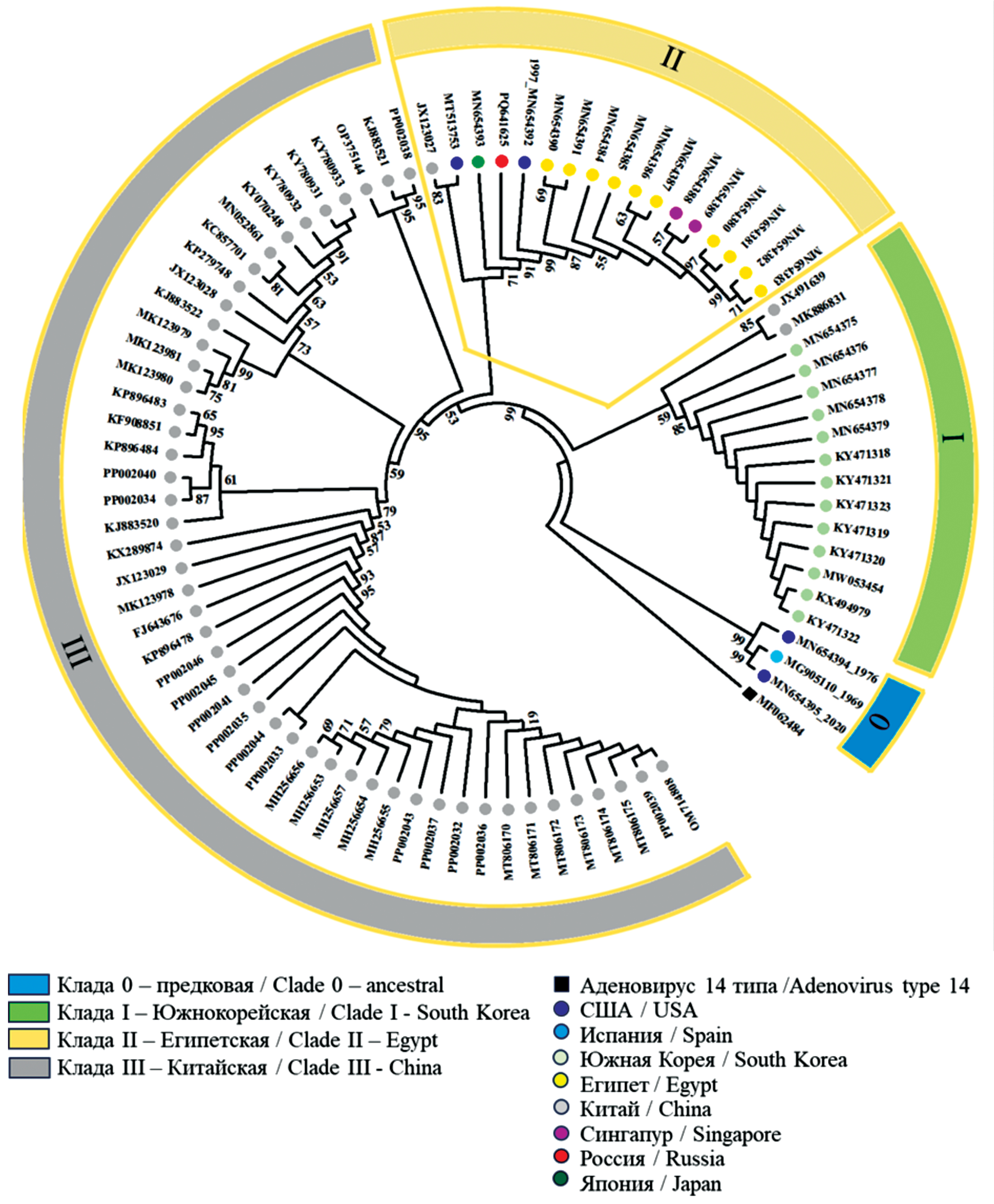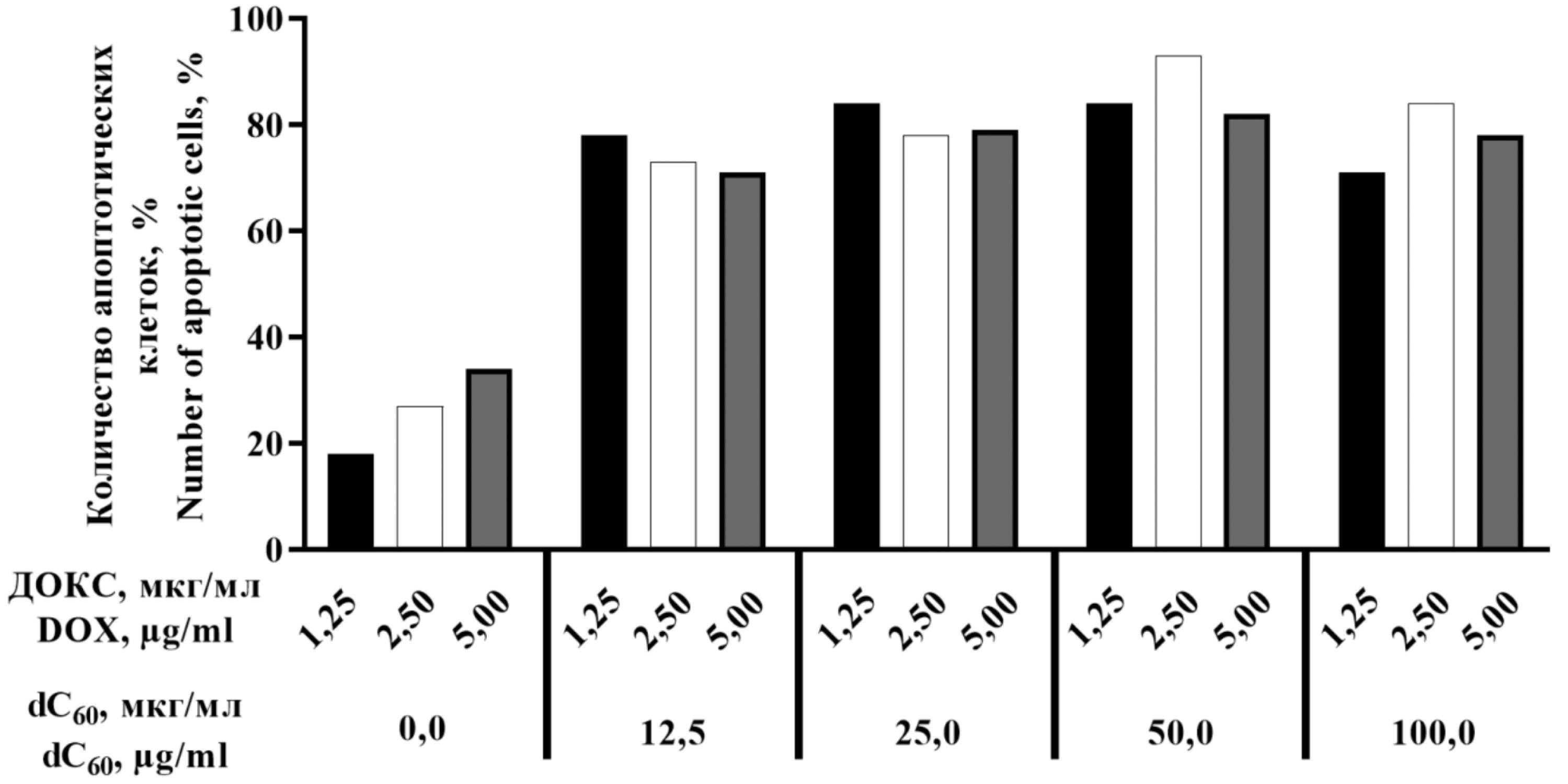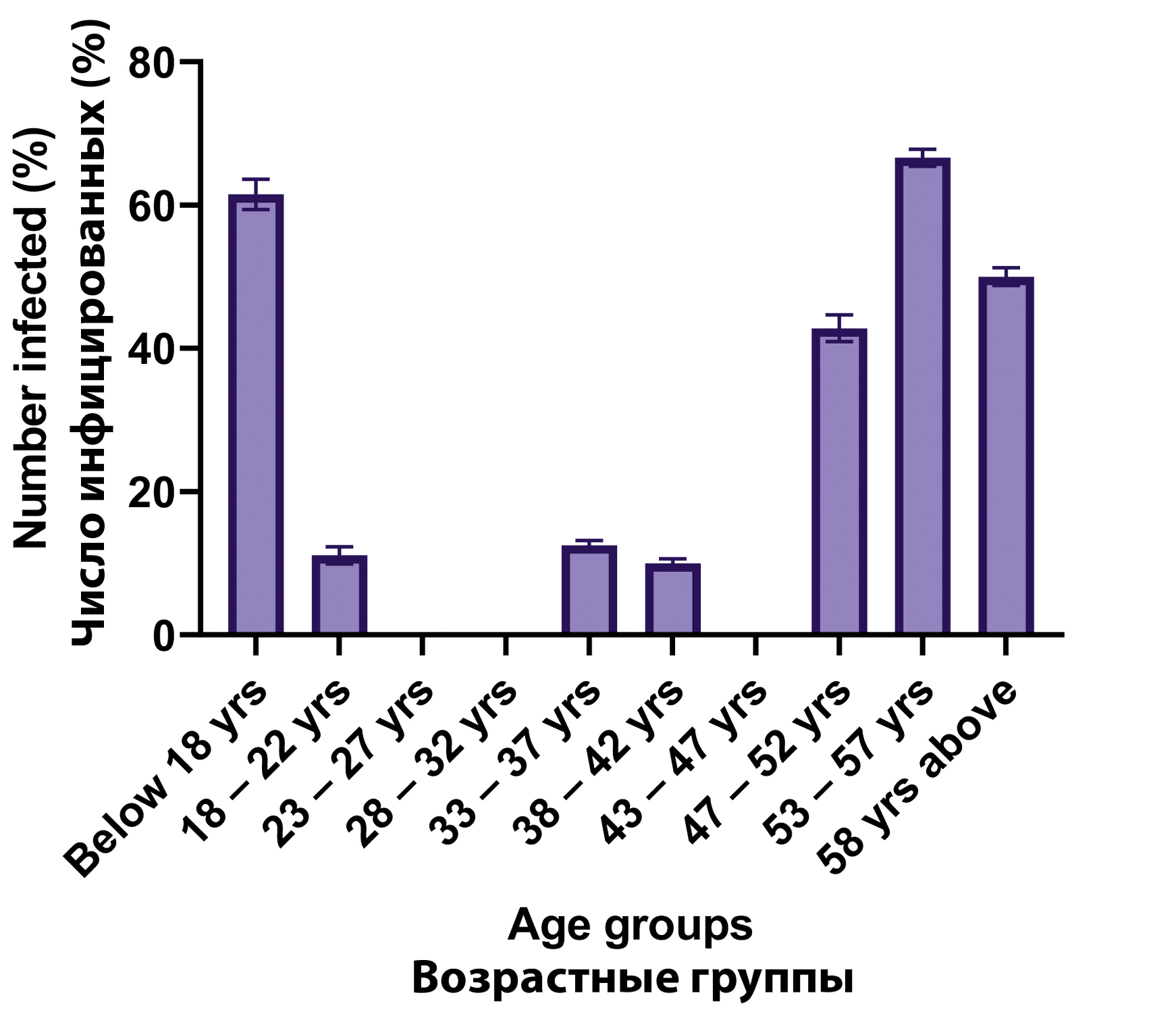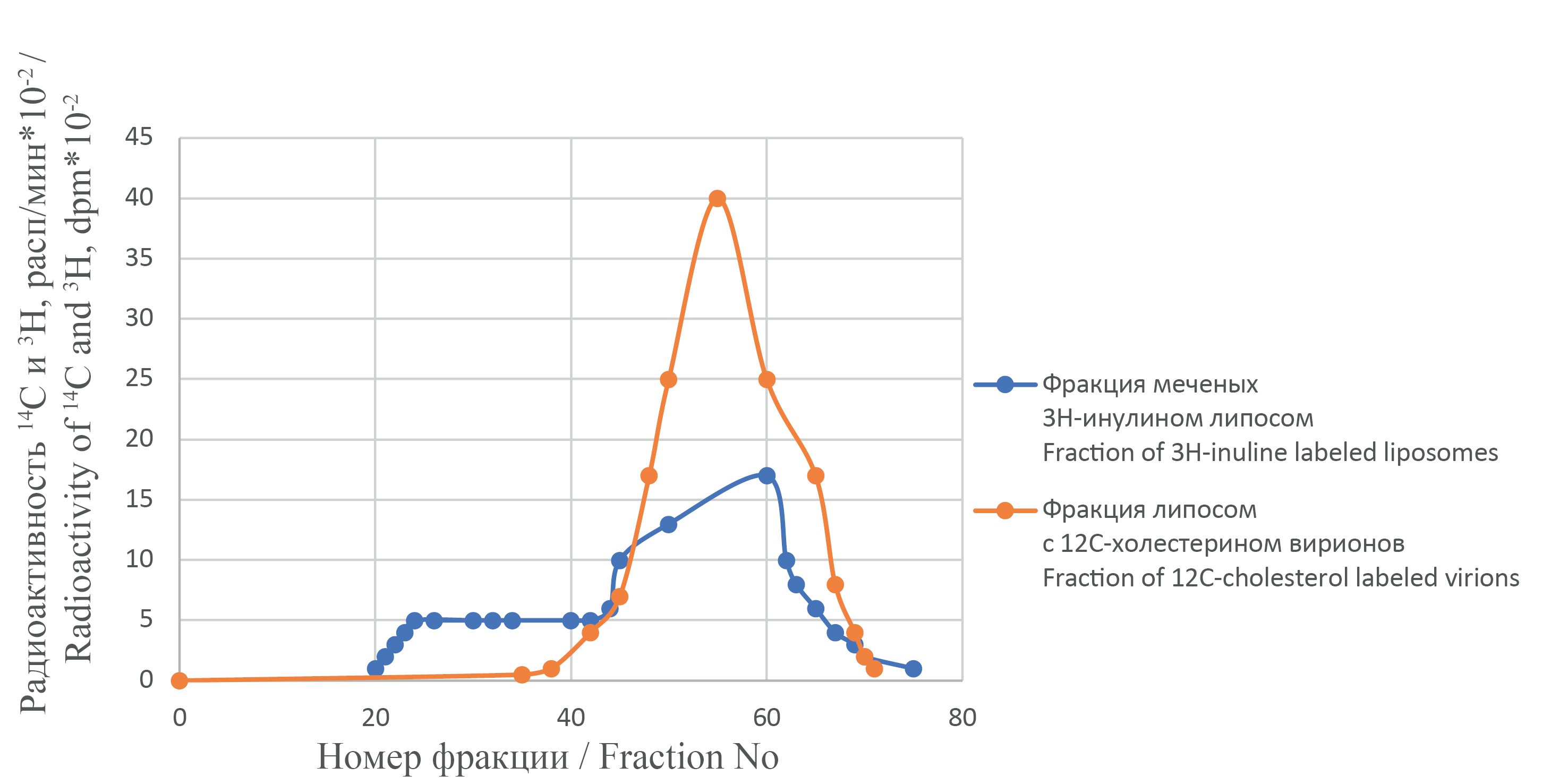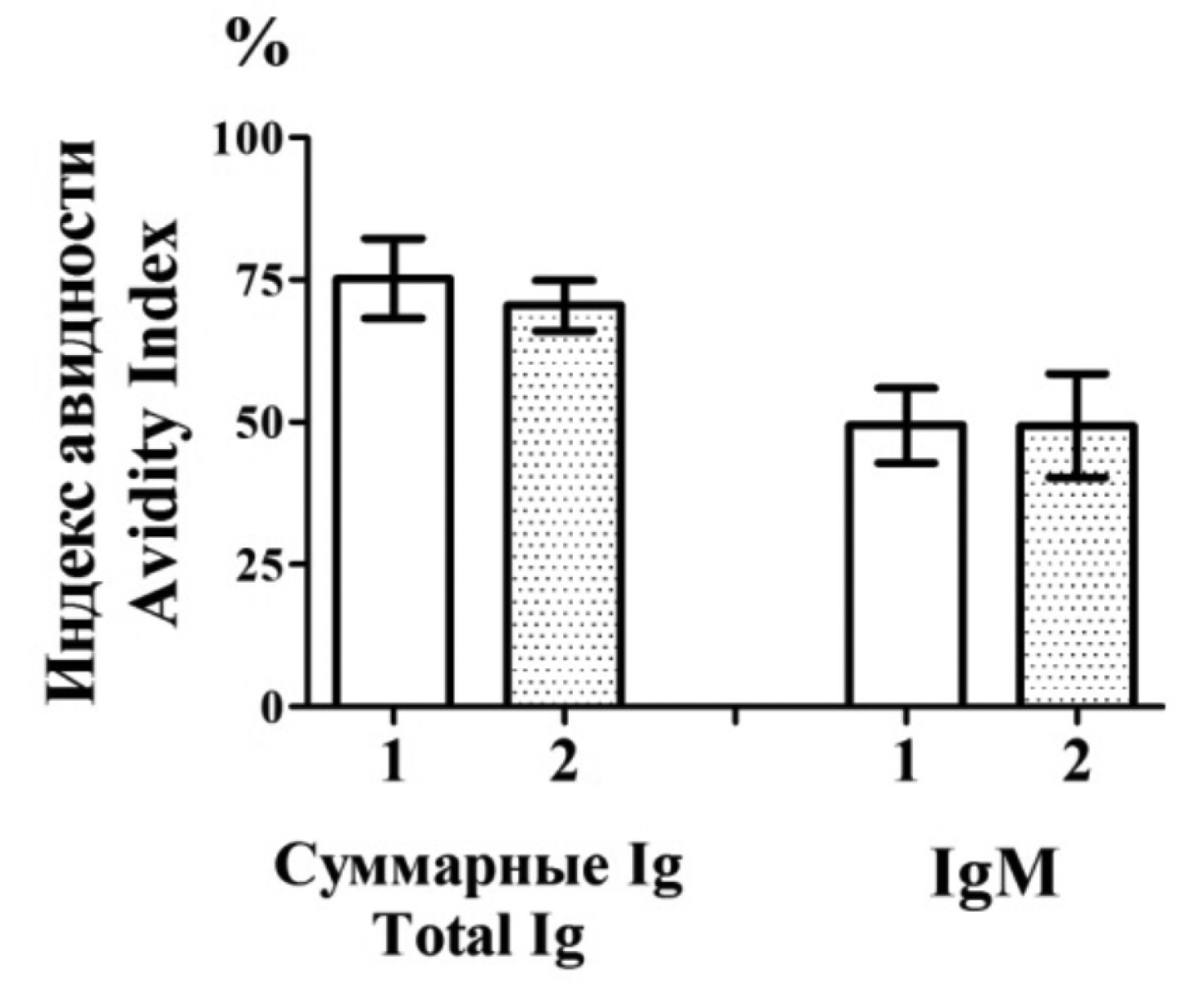Вопросы вирусологии
Международный рецензируемый научно-практический журнал «Вопросы вирусологии» (транслитерированное основное название «Voprosy virusologii», параллельное название - Problems of Virology, ISSN (Print) 0507-4088, ISSN (Online) 2411-2097) знакомит читателей с достижениями российской и мировой вирусологии, размещает на своих страницах статьи, посвященные изучению вирусов и вирусных болезней человека, животных и растений.
Видное место в журнале отводится публикации результатов экспериментальных работ по различным вопросам общей и частной вирусологии.
Журнал публикует материалы, способствующие внедрению в практику достижений вирусологической науки по ликвидации и снижению распространенности инфекционных заболеваний, а также их диагностике, профилактике и лечению.
В обзорных статьях обобщаются последние достижения в области вирусологии. С целью привлечения внимания вирусологов к наиболее актуальным вопросам, требующим дальнейшего изучения, в журнале публикуются редакционные заметки и рецензии на книги. Читатель найдет в журнале описание новых методов исследований, методических приемов, новой аппаратуры, средств диагностики и лечения.
Журнал рассчитан на вирусологов (медиков и ветеринаров), эпидемиологов, паразитологов, фармакологов, биохимиков и других специалистов.
«Вопросы вирусологии» - журнал открытого доступа, не берущий плату за публикацию научных статей.
Журнал входит в SCOPUS (Q4).
В соответствии с рекомендациями ВАК (Письмо ВАК от 06.12.2022 № 02-1198), журнал относится к категории К1 как издание, входящее в базы данных SCOPUS и RSCI.
Журнал, входит в рекомендованный ВАК «Перечень рецензируемых научных изданий, в которых должны быть опубликованы основные научные результаты диссертаций на соискание ученой степени кандидата наук, на соискание ученой степени доктора наук» (в соответствии с п.5 Правил формирования Перечня (Приказ Минобрнауки России от 12.12.2016 N 1586), как входящий в международную реферативную базу данных и систем цитирования Scopus) по специальностям:
- 1.5.10. Вирусология (медицинские и биологические науки)
- 3.2.2. Эпидемиология (медицинские и биологические науки)
- 3.1.22. Инфекционные болезни (медицинские и биологические науки)
- 3.3.6 Фармакология, клиническая фармакология (медицинские и биологические науки)
Журнал представлен в следующих международных базах библиографических данных и информационно-справочных системах: РИНЦ, RSCI (на платформе WoS), Abstract Journals, AIDS & Cancer Research, Biocontrol News and Information, Biological Sciences, Chemical Abstracts, DOAJ, EBSCOhost Biological Abstracts, EBSCOhost Wildlife & Ecology Studies Worldwide, Elsevier BV Scopus, Elsevier BV EMBASE, Index Medicus, Excerpta Medica, Index Veterinarius, MEDLINE, National Library of Medicine PubMed, Parasitology Database, Poultry Abstracts, Review of Medical and Veterinary Entomology, SCOPUS, Thomson Reuters Biological Abstracts, Thomson Reuters BIOSIS Previews, Thomson Reuters Science Citation Index Expanded, Thomson Reuters Web of Science, Tropical Diseases Bulletin, Veterinary Science Database, Virology and AIDS Abstracts, ROAD.
В 2022 г журнал вошел в DOAJ и удостоен DOAJ SEAL.
Контент доступен под лицензией Creative Commons — Attribution 4.0 International, CC-BY.
Каждой статье журнала присваивается идентификатор цифрового объекта — DOI.
Все публикуемые в журнале статьи, обзоры и лекции проходят обязательное двойное слепое рецензирование членами редколлегии и приглашенными экспертами.
Статьи иностранных авторов, а также русскоязычные статьи, отдельно рекомендованные редколлегией, публикуются на русском и английском языке под единым DOI. Перевод носителем языка и научное редактирование перевода производится за счет Редакции.
Журнал выходит 1 раз в 2 месяца (6 выпусков в год).
Журнал является органом Общероссийской общественной организации «Всероссийское научно- практическое общество эпидемиологов, микробиологов и паразитологов».
Учредители:
- ФБУН ЦНИИ Эпидемиологии Роспотребнадзора,
- Общероссийская общественная организация «Всероссийское научно-практическое общество эпидемиологов, микробиологов и паразитологов».
Издатель:
- ФБУН ЦНИИ Эпидемиологии Роспотребнадзора.
При регистрации на сайте читатели и авторы получают автоматические уведомления о содержании новых выпусков Журнала на адрес своей электронной почты с возможностью отписаться от рассылки.
Текущий выпуск
Том 70, № 5 (2025)
- Год: 2025
- Выпуск опубликован: 15.11.2025
- Статей: 8
- URL: https://virusjour.crie.ru/jour/issue/view/142
Весь выпуск
РЕДАКЦИОННАЯ КОНЦЕПЦИЯ
Таксономия и мегатаксономия вирусов (домен Vira) – текущий статус
Аннотация
Спустя 80 лет с момента открытия первого вируса нашим соотечественником Д.И. Ивановским установлено, что все организмы биосферы Земли являются природными хозяевами вирусов. Вирусы, объединенные в неформальный домен Vira, инфицируют все три домена биосферы: археи – Archaea, бактерии – Bacteria, эукариот – Eucarya (водоросли – Algae, грибы – Fungi, простейшие – Protozoa, растения – Plantae, беспозвоночные – Invertebrata, позвоночные – Vertebrata). Процесс формирования популяционных генофондов вирусов в результате взаимодействия с популяционными генофондами их хозяев происходил в условиях меняющейся среды обитания на протяжении 3,5 млрд лет и обеспечил огромное многообразие виросферы. Накопление данных о виросфере Земли, связанное с внедрением технологий массового параллельного секвенирования (NGS), привело к необходимости реконструкции подходов к классификации вирусов и реформированию, начиная с 2018 г., таксономии вирусов с введением новых высших рангов (мегатаксономия). На cентябрь 2025 г. для представителей виросферы Международным комитетом по таксономии вирусов (ICTV) приняты 15 таксономических рангов, основные из которых: надцарство (Realm) – 7, царство (Kingdom) – 11, тип (Phylum) – 22, класс (Class) – 49, отряд (Order) – 93, семейство (Family) – 368, род (Genus) – 3768, вид (Species) – 16 213. Дальнейший прогресс использования метагеномики, метатранскриптомики и глобальной экологии виросферы неминуемо приведет к дальнейшим изменениям в таксономии и мегатаксономии вирусов. Это будет иметь фундаментальное значение в понимании эволюции биосферы и прикладную значимость для разработки новых подходов обеспечения биологической безопасности и минимизации последствий чрезвычайных эпидемических событий, связанных с проблемой новых и возвращающихся (emerging and reemerging) инфекций.
 401-416
401-416


ОБЗОРЫ
Современные подходы к конструированию и применению рекомбинантных вирусов
Аннотация
В обзоре описан ряд вирусных векторов и рассмотрены различные методы конструирования рекомбинантных вирусов, особое внимание уделено системе гомологичной рекомбинации и CRISPR/Cas9, описана возможность использования разных клонирующих векторов (виды плазмид, BAC). Также в обзоре представлен сравнительный анализ эффективности и безопасности применения вирусных векторов как для создания рекомбинантных вакцин, так и для получения онколитических вирусов, препаратов для генной терапии.
 417-430
417-430


ОРИГИНАЛЬНЫЕ ИССЛЕДОВАНИЯ
Генетическая характеристика изолята аденовируса человека 55-го генотипа (Adenoviridae: Mastadenovirus), выделенного в Москве в 2022 г.
Аннотация
Введение. Аденовирусная инфекция встречается повсеместно в виде спорадических случаев и отдельных вспышек. Аденовирус человека 55-го генотипа (HAdV-55), эндемичный для территорий Китая и Южной Кореи, вызывает острые респираторные вирусные инфекции (ОРВИ) разной степени тяжести как среди гражданского населения, так и в воинских коллективах в разных странах мира. Геномные исследования способствуют достоверной идентификации HAdV-55.
Цель данной работы состояла в идентификации HAdV, выделенного в Москве в 2022 г., проведении полногеномного секвенирования и сравнительного геномного исследования.
Материалы и методы. HAdV-55 выделили из образца пациента, госпитализированного с пневмонией, исследовали методами анализа полиморфизма длины рестрикционных фрагментов и полногеномного секвенирования. Биоинформационный сравнительный анализ выполняли для выборки геномов 83 изолятов.
Результаты. Проведено полногеномное секвенирование изолята HAdV-55, впервые выделенного в РФ. Последовательность генома изолята SCV3008:Ad55 депонировали в GenBank (регистрационный номер PQ641625). Выявлены уникальные мутации в геноме SCV3008:Ad55, одна из которых приводила к консервативной замене T29A в пентоне, не влияющей на его функции. Филогенетический анализ показал кластеризацию SCV3008:Ad55 с изолятами клады II, включившей представителей 7 стран разных континентов, что свидетельствует о широком распространении HAdV-55. Изоляты эндемичных регионов Китая и Южной Кореи формировали отдельные клады. Исследование полиморфизма длин микросателлитов в нетранслируемых областях генома стало дополнительным инструментов различения близкородственных геномов.
Заключение. Сравнительное геномное исследование изолятов HAdV-55, появившегося в результате рекомбинации HAdV-14 и HAdV-11, показало медленное накопление мутаций с 1969 г. как в транслируемых, так и в нетранслируемых областях, позволило выявить уникальные замены нового изолята SVC3008:Ad55. Полученная геномная информация заложила основу для дальнейшего мониторинга HAdV-55 в России и продемонстрировала информативность и значимость полногеномных исследований для наблюдения за аденовирусами. Разработка и внедрение в практику методов генотипирования, нацеленных на выявление HAdV-55 и других клинически значимых генотипов, позволит значительно повысить эффективность диагностики аденовирусных инфекций с угрозой развития бронхопневмонии.
 431-443
431-443


Устойчивость и восстановление чувствительности опухолевых клеток, инфицированных цитомегаловирусом человека, к доксорубицину при сочетанном применении с дисперсным фуллереном dC60
Аннотация
Введение. Цитомегаловирусная инфекция способна индуцировать развитие резистентности опухолевых клеток к химиотерапевтическим препаратам посредством модуляции апоптотических путей. В поиске альтернативных препаратов, направленных на преодоление вирус-ассоциированной резистентности, перспективным направлением является применение наноматериалов (дисперсной формы фуллерена dC60). Возможность преодоления вирус-ассоциированной лекарственной устойчивости открывает новые возможности для разработки комбинированных терапевтических стратегий в лечении опухолей.
Цель ‒ оценить влияние цитомегаловирусной инфекции на резистентность клеток гепатокарциномы и промиелоцитарного лейкоза к доксорубицину, а также потенциал дисперсного фуллерена dC60 в восстановлении чувствительности к химиотерапии доксорубицином клеток моноцитарной лейкемии.
Материалы и методы. Исследовали клетки: гепатокарциномы (Huh 7.5), промиелоцитарного лейкоза (HL-60), моноцитарной лейкемии (THP-1); цитомегаловирус (штамм AD169). Экспериментальная часть включала общепринятые культуральные и вирусологические методы, иммуноцитохимию, иммуноблотинг, полимеразную цепную реакцию в режиме реального времени, полимеразную цепную реакцию с обратной транскрипцией, МТТ-тест.
Результаты. Цитомегаловирусная инфекция в клетках гепатокарциномы и промиелоцитарного лейкоза снижала цитотоксическое действие доксорубицина на ٣٠٪. В клетках моноцитарной лейкемии сочетанное применение доксорубицина с дисперсным фуллереном dC60 приводило к восстановлению чувствительности инфицированных клеток к химиотерапии. При этом 93% гибель опухолевых клеток достигалась с применением доксорубицина в ٢ раза меньшей концентрации.
Заключение. Цитомегаловирусная инфекция формирует резистентность к доксорубицину на гемопоэтических (клетки промиелоцитарного лейкоза и моноцитарной лейкемии) и солидных (клетки гепатокарциномы) опухолевых моделях. Примечательно, что сочетанное действие доксорубицина с дисперсным фуллереном dC60 не только позволяет преодолевать вирус-опосредованную лекарственную устойчивость в клетках моноцитарной лейкемии, но и позволяет достичь выраженного цитотоксического эффекта при сниженных концентрациях доксорубицина, что открывает перспективы для разработки комбинированных терапевтических схем со сниженной токсичностью.
 444-454
444-454


Серопревалентность вирусов гепатитов B и C и факторы риска среди медицинских работников (МР) в специализированных больницах в Браззавиле, Республика Конго
Аннотация
Введение. Вирусы гепатитов B и C вызывают хронические инфекции, приводящие к циррозу печени и гепатоцеллюлярной карциноме.
Целью данного исследования было определить серопревалентность вирусов гепатитов B и C и потенциальные факторы риска, которые могут влиять на распространенность среди медицинских работников (МР) в Браззавиле, Республика Конго.
Материалы и методы. Мы провели поперечное исследование с июня по ноябрь 2022 г. среди МР в специализированных больницах Талангаи и Макелекеле в Браззавиле. В исследование было включено 107 МР. Серологический скрининг проводили с использованием экспресс-тестов, а затем с подтверждением реактивных результатов в иммуноферментном анализе после заполнения анкеты.
Результаты. Средний возраст пациентов составил 36,56 ± 11,62 года, в когорте преобладали женщины (соотношение женщин и мужчин составило 1 : 0,36). Наиболее представительной социально-профессиональной категорией были лаборанты. Серопревалентность вируса гепатита В составила 7,48%, а вируса гепатита С – 3,74%. За время работы 40% МР являлись жертвами несчастных случаев, связанных с контактом с кровью, и имели в 7 раз больший риск заражения вирусом гепатита В (коэффициент шансов [ОШ] = 7,01 (95% доверительный интервал [ДИ] 1,54–31,96); p = 0,01).
Заключение. Полученные данные свидетельствуют о том, что вирусы гепатитов B и C по-прежнему широко распространены среди МР в Республике Конго. Можно сделать вывод, что МР являются группой высокого риска инфицирования вирусами гепатитов B и C. В этой связи необходимо улучшить условия труда и безопасности МР, внедрить новые стратегии для снижения профессионального контакта с кровью и биологическими жидкостями, а также снизить уровень заражения вирусами гепатитов B и C.
 455-462
455-462


Частота выявления антител класса IgG к вирусу Mpox и осведомленность о заболевании Mpox в Ибадане, юго-западная Нигерия
Аннотация
Цель. Ранее случаи Mpox были распространены среди детей; недавние вспышки, вызванные вирусом клады II, в основном затронули лиц молодого возраста. Исследование направлено на изучение знаний о вирусе Mpox и отношения к нему, а также серопревалентности среди когорты лиц в Ибадане, давших согласие на участие в исследовании.
Материалы и методы. К участию в исследовании были допущены добровольцы, соответствовавшие установленным критериям включения. Было проведено поперечное исследование с участием 94 респондентов для изучения социально-демографических факторов, уровня осведомленности, отношения к профилактике и уровня инфицирования. Антитела класса IgG к вирусу Mpox количественно определяли с помощью метода твердофазного иммуноферментного анализа (ИФА). Затем данные анализировали с использованием критерия χ2, а количественное определение антител отображали с помощью диаграммы типа «ящик с усами»; статистическую значимость определяли при p < 0,05.
Результаты. Большинство респондентов были женщинами (66,7%) в возрасте 58 лет и старше (20,0%). Большинство имели высшее (40,0%) и среднее образование (34,4%). Осведомленность об Mpox была умеренной: 61,1% опрошенных слышали о вирусе в основном из новостей (20,0%) и от работников здравоохранения (18,9%). Тем не менее пробелы в знаниях были очевидны: только 38,9% знали о симптомах заболевания и 40,0% понимали пути передачи вируса. Отношение к профилактике было в целом положительным; 60,0% считали, что Mpox можно предотвратить, и 73,3% были готовы вакцинироваться. Тем не менее готовность участвовать в скрининге была низкой; 81,1% респондентов никогда не проходили тестирование, а 58,9% не знали о доступности теста в их регионе. Что касается серопревалентности, у женщин частота выявления анти-Mpox была значительно выше (27,4%), чем у мужчин (9,6%) (χ2 = 3,854, p = 0,050). В возрастном разрезе самые высокие показатели серопозитивности наблюдались у лиц младше 18 лет (61,5%) и в возрасте от 53 до 57 лет (66,6%) (χ2 = 30,817, p = 0,000), что указывает на значительные возрастные различия.
Заключение. Полученные данные подчеркивают необходимость целевого просвещения в области общественного здравоохранения, расширения доступа к тестированию и разработки стратегий целенаправленного вмешательства для улучшения профилактики и контроля Mpox, особенно среди уязвимых возрастных групп и малоинформированного населения.
 463-470
463-470


В ПОМОЩЬ ВИРУСОЛОГУ
Диагностика инфекционного и гемагглютинирующего титра вируса гриппа А/Маллард Пенсильвания/10218/84 (H5N2) по изменению микровязкости вирусной мембраны после взаимодействия с фосфолипидными модификаторами на примере бесхолестериновых липосом
Аннотация
Введение. Противовирусное действие ряда препаратов связано с модификацией липидной мембраны вирусов вследствие их применения. Один из возможных механизмов такой модификации вирусной мембраны заключается в экстракции холестерина из мембран вирионов.
Цель работы. Изучить методику определения инфекционного и гемагглютинирующего титра вируса гриппа птиц по изменению микровязкости вирусной мембраны после инкубации с фосфолипидными модификаторами ‒ бесхолестериновыми липосомами, состоящими из фосфатидилхолина и фосфатидилэтаноламина в мольном отношении 1 : 2, в течение 48 ч.
Материалы и методы. Процесс экстракции подтверждали двумя методами: гель-фильтрацией с радиоактивно меченными липосомами и вирионами, а также по изменению величины поляризации флуоресцентного зонда 1-анилинонафталин-8-сульфонат-аниона (8-АНС) в вирусной мембране.
Результаты. Обнаружена корреляционная связь между изменением инфекционного и гемагглютинирующего титра и микровязкостью вирусной мембраны.
Заключение. Предложенная в работе методика позволяет проводить количественное определение инфекционной и гемагглютинирующей активности вируса гриппа в зависимости от изменений микровязкости мембран вирусов после взаимодействия фосфолипидных модификаторов. Представляется возможным использовать выявленную зависимость для определения инфекционной и гемагглютинирующей активности вируса гриппа в пределах одного серотипа в клинической лабораторной диагностике, применяя различные флуоресцентные зонды. В качестве липофильных модификаторов вирусной мембраны можно использовать не только липосомы определенного состава, но и такие соединения, как этиленгликоль, эритрит, глицерин.
 471-476
471-476


Антитела против VP3 echovirus 30 (Picornaviridae: Enterovirus: Enterovirus betacoxsackie) нейтрализуют вирус in vitro
Аннотация
Введение. Широкая распространенность энтеровируса echovirus 30 (E30) и случаи тяжелого течения инфекции указывают на необходимость разработки средств иммунопрофилактики. В структуре поверхностного белка VP3 ряда энтеровирусов найдены эпитопы для нейтрализующих антител и Т-клеточного ответа. Однако иммуногенные свойства VP3 E30 не изучены.
Целью настоящей работы явилась характеристика иммуногенности капсидного белка VP3 E30 и изучение вируснейтрализующих свойств антител против VP3 Е30.
Материалы и методы. Рекомбинантный VP3Е30 и химерный белок SN-VP3E30, состоящий из S-региона VP1 норовируса и полноразмерного VP3 Е30, экспрессировали в Escherichia coli. SN-VP3E30 использовали для формирования вирусоподобных частиц (ВпЧ). Действие SN-VP3E30 на дендритные клетки (ДК) человека оценивали методом проточной цитофлуометрии по изменению экспрессии HLA-DR, CCR7, CD80, CD83 и CD86. Для исследования иммуногенных свойств SN-VP3E30 иммунизировали мышей линии BALB/c и морскую свинку. Титры антител и их авидность определяли методом иммуноферментного анализа. Взаимодействие антител против VP3 с вирусом Е30 изучали с помощью иммуноэлектронной микроскопии. Способность нейтрализовать вирус исследовали в культуре клеток эмбриональной рабдомиосаркомы (RD).
Результаты. Рекомбинантный VP3Е30 вызывал неполное созревание ДК человека, характеризующееся отсутствием стимуляции экспрессии хемокинового рецептора CCR7. Включение VP3 в состав химерных ВпЧ приводило к полному созреванию ДК и сильному гуморальному иммунному ответу у лабораторных животных. Антитела против VP3 характеризовались высокой авидностью, способностью вызывать агломерацию вирусных частиц in vitro и нейтрализовать вирус Е30 в культуре клеток RD.
Заключение. Полученные результаты свидетельствуют о том, что VP3 может быть использован в качестве антигена в составе субъединичной вакцины против энтеровируса Е30.
 477-486
477-486






